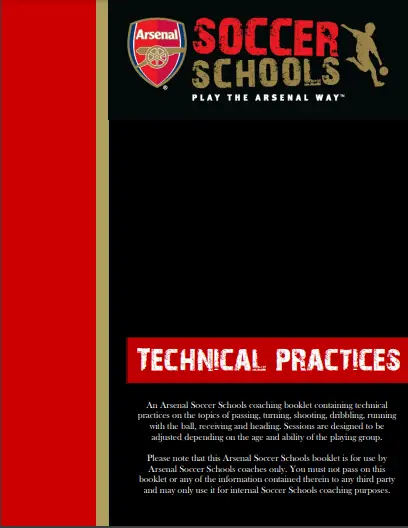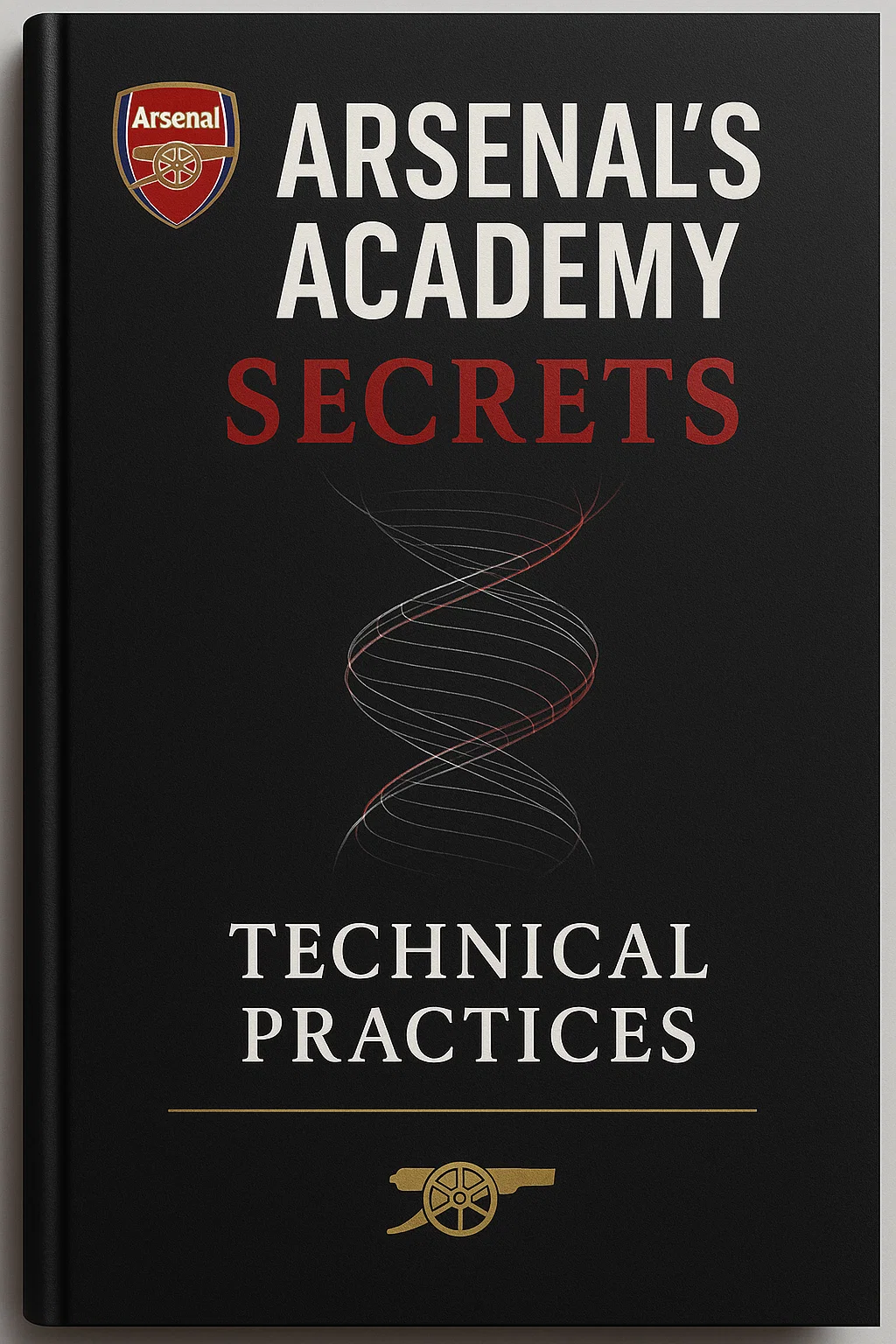Arsenal’s Academy Secrets: TECHNICAL PRACTICES – Cultivating The Intelligent Player

Arsenal’s Academy Secrets: TECHNICAL PRACTICES – Cultivating The Intelligent Player
The training philosophy at Hale End, Arsenal’s revered youth academy, is deeply rooted in the legacy of Arsène Wenger and the club’s commitment to aesthetically pleasing, technical football. The Álbum de entrenamiento of Arsenal is thus a manifesto for technical superiority and cognitive mastery, aiming to develop not just athletes, but ‘intelligent players’ capable of intricate combination play under intense pressure. This blueprint focuses heavily on technical practices that are inextricably linked to tactical outcomes, ensuring that every touch of the ball serves a strategic purpose.
The Core Mandate: Technical Non-Negotiables and The Training Plan
The foundation of Arsenal’s academy is a set of rigorous technical non-negotiables. Every player, regardless of position, must possess elite standards in passing accuracy, ball control, and body orientation (scanning). This commitment to primary technical excellence is established from the youngest age groups, providing the essential toolkit for the complex tactical systems they will encounter in the senior ranks.
Consequently, the development pathway is highly structured, aligning basic technical repetitions with advanced tactical concepts. Coaches refer to a detailed curriculum that guides this progression, ensuring uniformity in teaching methods across all age groups. This systematic approach is crucial, echoing the rigorous planning found in high-level coaching guides like The Training Plan, and serves as the preparatory groundwork before players tackle the complexity of systems outlined in documents such as the Essential 3-5-2 and 3-4-3 Training Exercises PDF.
Building Positional Fluidity through Technical Repetition
A key element of Arsenal’s philosophy is the cultivation of positional versatility and fluidity. Full-backs must be comfortable in central midfield positions, and central midfielders must be adept at recognizing and exploiting space in the final third. Therefore, technical practices frequently involve positional rotations and overloads, forcing players to execute demanding skills outside their primary comfort zone. This method ensures that the technical quality remains consistent, irrespective of the player’s location on the pitch.
This deep integration of technical skill and tactical role is essential for success in modern football. Coaches seeking to implement such complex systems can find useful structural inspiration in professional frameworks, particularly the detail required for mastering advanced play models as seen in the UEFA Pro License Course PDF. Furthermore, the emphasis is always on tempo; technical quality must be performed at match speed, transforming simple drills into high-intensity, decision-making tasks.
Game-Based Learning: Integrating Skill and Strategy through 60 Training Games
Arsenal’s technical training rarely involves abstract, repetitive cone drills. Instead, the club extensively employs a Constraints-Led Approach (CLA), where technical refinement occurs naturally within small-sided games (SSGs) or positional scenarios. This ensures that the player’s mind is actively engaged in solving a game-specific problem while simultaneously executing a technical skill.
In stark contrast to traditional, segmented methods, every drill is a mini-game. These constraints might include limiting touches, mandating positional switches after scoring, or requiring a specific combination of passes before a shot can be taken. This ensures that the technical execution is always linked to tactical purpose. Practical, game-based inspiration for this methodology is abundant in resources like the 60 Training Games PDF.
Developing Attacking Intent and Finishing Technique
Arsenal’s renowned attacking style, emphasizing quick combinations and intelligent movement, is a direct result of these targeted technical practices. Sessions focus intensely on breaking down defensive blocks through quick one-two passes, overlapping runs, and third-man movements. The attacking philosophy is meticulously detailed, often leveraging the principles taught in technical manuals such as Principles of Play Attacking PDF.
Specifically, finishing drills are always preceded by a realistic build-up phase, simulating the match environment. This is a crucial distinction from basic target practice, as it trains the player to shoot when fatigued and under the cognitive load of decision-making. Even simple routines, like the Warm-Up Exercises with Ball PDF, are adapted to include cognitive triggers, maintaining player focus from the moment they step onto the pitch.
The Academy Pipeline: From Sheffield United F.C. U14 Academy to Hale End
Arsenal’s academy pathway ensures a consistent technical and tactical language from the earliest stages. The challenge for Hale End is to identify talent early and then mold it into the Arsenal prototype—a player possessing both technical audacity and tactical discipline. The club continuously benchmarks its development against other elite systems. While a Sheffield United F.C. U14 Academy might focus on certain physical attributes, Arsenal maintains a firm commitment to the ball-playing DNA.
Structured Technical Curricula
The coaching staff at Hale End operates with a clear, published curriculum detailing expected technical milestones at every age group. This level of documentation is comparable to the exhaustive detail found in structured coaching certificates. Coaches rely on the core principles outlined in guides such as the UEFA B License Coaching Manual PDF and refine them with Arsenal-specific technical demands. Consequently, the players move through the system, consistently encountering the same cues and language, which speeds up tactical understanding.
- Age-Specific Adaptation: While the technical goal remains the same (excellence), the complexity of the tactical context increases with age. Younger players might focus on fundamental ball manipulation (as per UEFA B License Coaching Sessions PDF), while older players integrate that skill into complex 11v11 scenarios found in advanced sessions, mirroring the content of UEFA A Coaching Session Plans.
- A Holistic View: Arsenal acknowledges that football is a global sport, and their methodology is informed by successful approaches worldwide. While respecting unique philosophies (like those detailed in the highly systemized Marcelo Bielsa’s Football Philosophy PDF), Arsenal adapts them to fit their distinctive technical profile.
Physical Preparation and Injury Prevention: Beyond Standard Soccer Training Programs
Technical superiority is useless without the physical capacity to execute skills consistently for 90 minutes. Arsenal’s performance department, therefore, manages the physical load to support the technical and tactical intensity. This involves sophisticated monitoring and individualized programs that go far beyond generalized plans.
Moreover, the club invests heavily in injury prevention, with tailored strength and conditioning programs that address the physical demands of high-speed technical play. This specialized focus separates elite methodologies from general Soccer Training Programs. The goal is to build robust players who can withstand the constant, high-tempo technical demands of the Premier League. This modern, integrated approach reflects the comprehensive requirements for advanced coaching qualifications, such as those covered in the AFC B Diploma Coaching Course Certificate PDF.
Mental Fortitude: The Psychological Edge
Ultimately, technical excellence must translate into decisive actions under pressure. The psychological component is therefore integrated into the technical practices. This aspect of the curriculum, which focuses on developing leadership, resilience, and effective communication, is as important as technical skill. In conclusion, modern footballing development requires a level of psychological depth that aligns with the highest coaching standards, thoroughly discussed in comprehensive documents like UEFA A Licence: The Complete Coach’s Guide PDF.
Conclusion: The Unending Quest for Technical Perfection
The Arsenal’s Academy Secrets: TECHNICAL PRACTICES manual is the embodiment of a club DNA focused on precision, intelligence, and beautiful football. The system—from the foundational technical non-negotiables to the integrated psychological development—is designed to produce first-team ready players who are not just physically capable but technically and tactically fluent in the Arsenal way.
This relentless focus on technical quality embedded within game context, supported by a strong foundation of sports science (as explored by the rigorous standards of the Leicester City Football Club Academy PDF), has provided the bedrock for Arsenal’s enduring success and their recent resurgence. The flow of talent from Hale End, culminating in successful senior careers, is a clear vindication of this philosophy.
To appreciate the success of the Hale End system further, analyzing the specific financial impact of their youth graduates offers compelling evidence of the academy’s value, often detailed in football business analyses from reputable sources like Forbes. Furthermore, exploring the club’s historical transfer market strategy over the last decade, readily available on Transfermarkt’s Arsenal page, shows the critical role the academy plays in financial sustainability.
To delve deeper into the implementation of this technical mastery, coaches are encouraged to examine the principles of small-sided games and constraint-led coaching, which build upon the foundational game-based ideas presented in the 60 Training Games PDF, and the tactical planning necessities detailed in The Training Plan.

